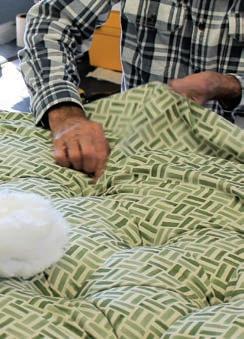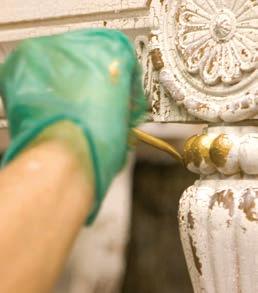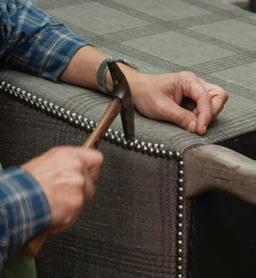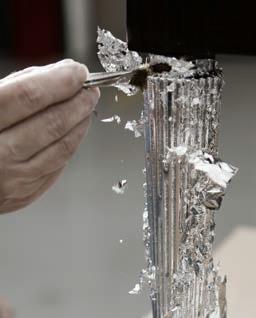
4 minute read
NORTH CAROLINA CUSTOM FURNITURE MANUFACTURING PROCESSES
North Carolina is well-known around the world for its quality craftsmanship and custom manufacturing processes that make furniture production so unique to our state and our region. Below are some of the most commonly requested custom manufacturing processes and specialty finishes offered by our incredibly talented and skilled North Carolina craftsmen and manufacturers.
Button Tufting

Experienced craftsmen create indentions at regular intervals across the top of the cushion by passing a long needle and thread through to the back side of the furniture’s frame. The thread is then pulled taut and tied so that the hand applied buttons remain firmly in place.
Eight-Way Hand-Tied

This construction technique has been passed down through generations of North Carolina craftsmen and is an art which takes a lot of time and patience. Steel bands are stretched underneath strips of webbing and are double nailed to the frame. This eliminates the possibility of future sagging. Double cone coil springs are securely nailed to the hardwood frame and then skilled craftsmen tie these springs by hand in eight different directions, from side to side, front to back, and diagonally, which provides outstanding firm support and long-lasting comfort. Truly a North Carolina quality process requested by customers around the world.
Gold Brushing

One finish technique of particular beauty is gold brushing. Through this process, a skilled artisan uses a sealer and a fine gold dust finish material to hand brush on gold highlights to specific areas of furniture that the customer has requested.
Hand Cutting Fabric and Leather
Cutting fabric and leather upholstery is an art form that takes years of experience and a skilled eye for extreme detail. Every piece of furniture calls for a unique cutting pattern and every fabric and leather have their own special qualities that require a talented cutter to thoughtfully combine the two and create a matched piece. When cutting fabrics, stripes, plaids, florals, and plains must all be handled differently. When cutting leathers, an experienced craftsman needs to identify and remove any cow branding or defects in the grain.
Hand Forging
Steel furniture may be shaped using either a power hammer or bent using a custom jig. In order for this to occur, the steel needs to be heated in a forge to approximately 1200 degrees, at which point the steel is soft enough to be shaped. Blacksmiths train for months to acquire the skills needed to master this specialized technique.
Handmade Wood Frames & Products

Every day talented North Carolina craftsmen build oneof-a-kind custom wood frames and products to order.
Each piece is made one at a time, crafted individually by hand, in the right size, veneer, finish, and design, with the ultimate goal to create a quality piece of durable furniture that will last a lifetime.
Hand Painting on Leather or Wood

Creative artists start this process by either lightly buffing the leather or sanding the wood, then the artist paints the chosen design completely by hand. After the paint is applied to the piece of furniture, the leather or wood is then treated to protect the painting, which ensures the longevity of the artwork. Hand painting may be applied to almost any furniture surface. Hand painting on leather is commonly placed on the front, back, side of the arm or even on the cushion of a chair or sofa, while hand painting on wood is often applied to bedroom headboards, chests, mirrors, or other statement pieces.
Leather Bullion Fringe Finishing

Leather bullion fringe is a type of decorative trim that is applied on the outside of a piece of furniture to portray a frayed look. Originally bullion fringe was made only from plain or crepe cords, but now it is commonly used on leather to create a more sophisticated looking piece.
Nail Head Trim

A type of quality finish where decorative nails of assorted sizes, finishes and designs are applied directly onto furniture using high powered nail guns and then refined by human hands for completion. Nail heads not only secure fabric and trim in place, but they also help to finish edges and cover tacks and seams in upholstered pieces. Nail head trim is applied only by highly skilled craftsmen who have studied and learned this technique through years of experience. They are extremely precise in this process.
Quilting
Quilting is a decorative process that is often applied to both fabric and leather upholstered pieces. Because of the extra fill required to created quilted pieces, they make for truly luxurious seating options. The most common quilting options to accent your furniture are diamond (one seam), double diamond (two seams), and channel (parallel lines) in both horizontal and vertical orientations.
Silver Leafing

The process of silver leafing begins with a smoothly sanded, prepped wooden surface. Silver enamel is then applied by spraying it on in an even wet coat. After the enamel is dried and hand-sanded, a thin layer of glue that is specifically designed for leafing is rolled onto it. Trained decorators then hand apply each square in an even uniformed pattern across this freshly glued surface. Two applications of sealer are then sprayed across the entire surface and a glaze (a pigmented material) is sprayed on and wiped off leaving a soft, rich color to the leaf. A sealer clear coat is then sprayed onto the glazed surface following a clear coat lacquer, giving it a more finished and smoother glossy surface. Soft sanding may be used as a last step if needed.
Upholstery

A highly skilled craft that involves padding and covering seats, chairs and sofas with fabric or leather or a combination of both. Each piece of custom upholstery is bench made by hand by a team of experts specializing in their area of expertise. Frames are built to order, and fabric patterns are cut by hand one at a time in such a way that allows the patterns to meticulously flow and match perfectly throughout the entire piece. This is another North Carolina quality process that is widely requested around the world.
Welting

A welt cord is simply a fabric covered cord that follows the seam of a chair cushion, sofa cushion, or pillows. A welt cord helps give upholstery a more finished and tailored look. The two types of welt cords most commonly used are a self-welt & a contrasting welt. Contrasting welt cords often are an effortless way to add style & pop to any upholstery piece










